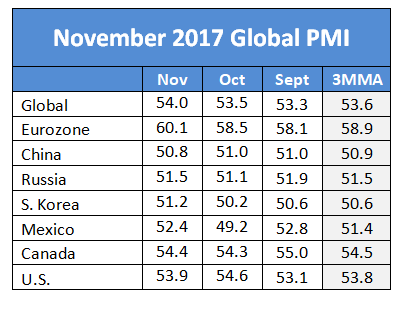Economy

Global Manufacturing Robust in November
Written by Sandy Williams
December 1, 2017
Global manufacturing accelerated to an 80-month high in November, according to the latest J.P. Morgan Global Manufacturing PMI. Output, new orders and employment were at multi-year highs. Demand led to capacity pressure and a resulting increase in employment. The PMI, produced by J.P. Morgan and IHS Markit in association with ISM and IFPSM, posted 54.0 in November, up from 53.5 in October. The reading was the highest since March 2011 and the 21st consecutive month of expansion.

Manufacturing in the Eurozone neared a record high in November, posting a PMI of 60.1 from 58.5 in October. Output and new orders were at multi-year highs, supporting the steepest increase in employment since the survey began in 1997. Export business rose at its fastest pace across the region with stronger trade flows noted by IHS Markit from the U.S., Asia, and between EU nations.
All countries in the Eurozone reported manufacturing expansion last month, led by Germany, the Netherlands and Austria. The surge in demand exceeded supply, leading to severe bottlenecks in the supply chain. IHS Markit said a shift to a sellers’ market is occurring with inflationary prices at their highest in six years.
“Companies are clearly expanding rapidly,” said Chris Williamson, Chief Business Economist at IHS Markit. “Employment growth has hit an all-time high and business investment on machinery is trending sharply upwards, suggesting manufacturers are looking forward to the upturn persisting well into 2018.”
Manufacturing activity in China improved in November, but only marginally. The Caixin China PMI registered 50.8, down from 51.0 the previous month. A modest rise in output and new orders led to weaker buying activity. Input costs rose sharply and were reflected in higher selling prices. Employment declined as companies cut costs.
“For the most part, the manufacturing sector remained stable in November, although some signs of weakness emerged,” commented Dr. Zhengsheng Zhong, Director of Macroeconomic Analysis at
CEBM Group. In the fourth quarter, the economy is likely to maintain the stability observed since the start of the second half of the year. Economic growth in 2017 is expected to be higher than last year, but it may come under downward pressure in 2018.”
The PMI in Russia rose slightly to 51.5 from 51.1 in October, indicating moderate manufacturing expansion. New orders rose at the strongest rate since July and production increased to meet stronger domestic demand. Input costs were elevated due to higher raw material costs. Manufacturer confidence was linked to new product development and stronger demand from clients. IHS Markit revised its industrial forecast downward for 2017, expecting a 1.7 percent increase in industrial production for the year.
The PMI improved to 51.2 in South Korea from 50.2 in October. Most of the new order growth came from domestic demand as export levels remained unchanged. Output grew at the strongest rate in 33 months. Raw material costs increased during the month, especially for oil and metals. Higher costs were passed on to customers. Backlogs accumulated for the third month in a row, but did not lead to changes in employment levels.
The PMI in Mexico recovered in November to 52.4 after registering 49.2 following the earthquakes in the region. New orders expanded sharply on domestic orders as well as a new export orders. Raw material inventories grew as manufacturers stocked up to meet demand, while accumulation of post-production stocks increased even quicker. Employment was buoyed by the surge in demand. Input and output costs were at five-month highs. IHS Markit noted an improvement in business confidence from October’s seven-month low. “Mexican manufacturers expect greater client bases, expansions into new export markets, product diversification and innovation to support output growth in the coming 12 months,” wrote IHS Markit Principal Economist Pollyanna De Lima.
Canada manufacturing output slowed in November. Output volume eased to its slowest rate in almost a year. New order growth picked up slightly, but was below the average seen in the first half of 2017. The IHS Markit Canada Manufacturing PMI was nearly unchanged at 54.4 in November from 54.3 in October. The rebound in energy sector spending and domestic demand was not enough to offset reduced export sales that were mostly attributed to weaker spending from U.S. clients. Raw material inventories increased slightly, while finished goods inventory declined at the sharpest pace since October 2010. Operating costs increased at its fastest rate in three-and-a-half years as manufacturers paid more for raw materials. Higher prices were noted for metals, plastics and packaging.
Improved operating conditions but slightly slower overall growth was seen by U.S. manufacturers in November. The IHS Markit PMI fell to 53.9 last month from 54.6 in October. Output increases were slightly softer than the previous month, but new orders rose at the second fastest pace since March. Demand accelerated domestically and from abroad. Increased costs were passed to clients in higher average prices. Shipping delays contributed to input price inflation. The level of outstanding business grew at the fastest pace since April and employment levels grew as firms looked forward toward expansion. “The sector is on course for its best quarter since the opening months of 2015,” said IHS Markit.
“What’s especially encouraging is that growth is being led by producers of business equipment and machinery, indicating investment spending is on the rise,” commented Chris Williamson. “Jobs growth in the sector has also picked up in recent months compared with the subdued hiring earlier in the year, suggesting that an expansionary mood is beginning to prevail in the goods-producing sector. Business optimism is now at its highest since the start of 2016, underscoring how firms believe the upturn has further to run as we move into 2018.”

Sandy Williams
Read more from Sandy WilliamsLatest in Economy

Steel groups welcome passage of budget bill
Steel trade groups praised the passage of the Big Beautiful Bill (BBB) in Congress on Thursday.

Industry groups praise Senate for passing tax and budget bill
The Steel Manufacturers Association and the American Iron and Steel Institute applauded the tax provisions included in the Senate's tax and budget reconciliation bill.

Chicago PMI dips 0.1 points in June
The Chicago Purchasing Managers Index (PMI) slipped 0.1 points to 40.4 points, in June.

Multi-family pullback drives housing starts to 5-year low in May
US housing starts tumbled in May to a five-year low, according to figures recently released by the US Census Bureau.

Architecture firms still struggling, ABI data shows
Architecture firms reported a modest improvement in billings through May, yet business conditions remained soft, according to the latest Architecture Billings Index (ABI) release from the American Institute of Architects (AIA) and Deltek.
